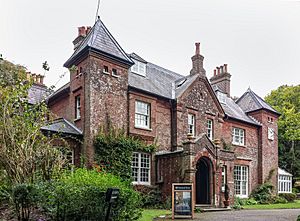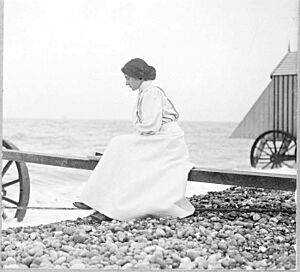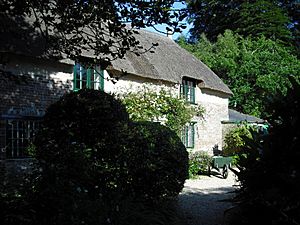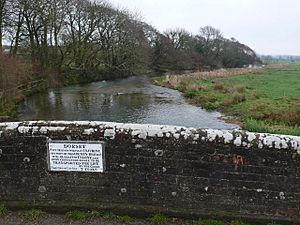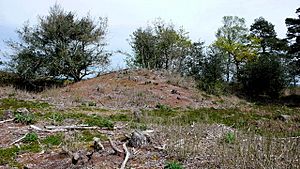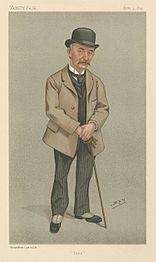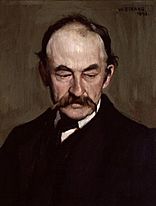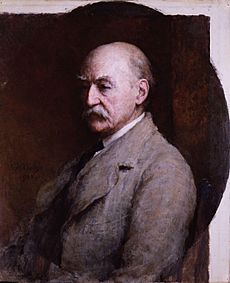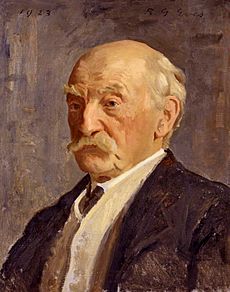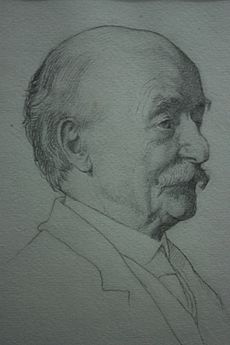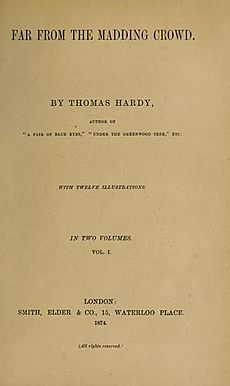Thomas Hardy facts for kids
Quick facts for kids
Thomas Hardy
|
|
|---|---|
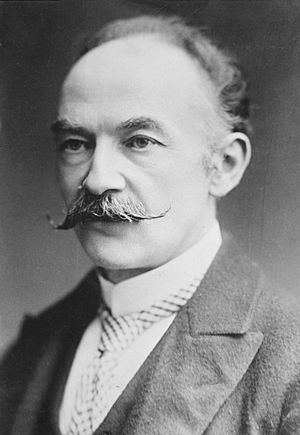
Hardy between about 1910 and 1915
|
|
| Born | 2 June 1840 Stinsford, Dorset, England |
| Died | 11 January 1928 (aged 87) Dorchester, Dorset, England |
| Resting place |
|
| Occupation | Novelist, poet, and short story writer |
| Alma mater | King's College London |
| Literary movement | Naturalism, Victorian literature |
| Notable works | Tess of the d'Urbervilles Far from the Madding Crowd The Mayor of Casterbridge Collected Poems Jude the Obscure |
| Spouse |
|
| Signature | |
 |
|
Thomas Hardy (born June 2, 1840 – died January 11, 1928) was a famous English writer. He wrote many novels and poems. He is known for showing real life in Victorian England. He often wrote about the struggles of people in the countryside.
Hardy saw himself mostly as a poet. But he first became famous for his novels. These include Far from the Madding Crowd (1874) and Tess of the d'Urbervilles (1891). Many of his stories are set in a made-up region called Wessex. This area is based on the real counties of Dorset, Wiltshire, and Somerset in England.
Contents
Life and Career
Early Life and Education
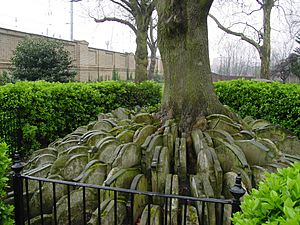
Thomas Hardy was born on June 2, 1840. His family lived in a small village called Higher Bockhampton in Dorset, England. His father was a stonemason and builder. His mother, Jemima, loved to read and taught Thomas at home.
When he was eight, Thomas went to school in Bockhampton. Later, he attended Mr. Last's Academy in Dorchester. There, he learned Latin and showed he was very smart.
Hardy's family could not afford to send him to university. So, at 16, he became an apprentice to a local architect named James Hicks. He helped design buildings, including a church.
In 1862, Hardy moved to London. He studied at King's College London. He even won awards for his architecture work. He also helped dig up part of a graveyard in London. This was before a railway was built there.
Hardy did not feel comfortable in London. He noticed the big differences between social classes. He became interested in making society better. He read books by thinkers like John Stuart Mill.
After five years, he returned to Dorset. He decided to focus on writing full-time.
Family Life
In 1870, Hardy met Emma Gifford while working on a church in Cornwall. They fell in love and married in 1874. In 1885, Thomas and Emma moved into Max Gate. This house was designed by Hardy himself.
Emma died in 1912. Her death deeply affected Hardy. He visited places where they had spent time together. He wrote many poems about her, showing his sadness.
In 1914, Hardy married his secretary, Florence Emily Dugdale. She was much younger than him. Even after marrying Florence, he still thought a lot about Emma. He wrote poetry to help him deal with his feelings.
Hardy was honored in 1910. He was made a Member of the Order of Merit. He was also nominated for the Nobel Prize in Literature twice.
Hardy and the Theatre
Hardy was interested in plays from a young age. He worked with others to turn his novels into plays. One play, The Trumpet-Major, was very successful. It was performed by a local group called the Hardy Players. Hardy even wrote a play just for them.
Later Years and Legacy
Hardy cared about old buildings. He joined a group that worked to protect them. He wanted to make sure old places were not destroyed or changed too much.
During World War I, Hardy was upset by the fighting. He believed that countries should try to understand each other. He felt this was the only way to save the world.
Thomas Hardy became ill in December 1927. He died on January 11, 1928, at his home, Max Gate. He was 87 years old.
His funeral was held at Westminster Abbey. Hardy had wanted to be buried with his first wife, Emma. So, his heart was buried in Stinsford with Emma. His ashes were placed in Poets' Corner at Westminster Abbey.
After he died, many of his letters and notebooks were burned. But some survived. These have helped people understand his work better. Many younger writers admired Hardy's stories and poems. His birthplace and Max Gate are now owned by the National Trust. Visitors can explore these places.
Novels
Hardy's first novel, The Poor Man and the Lady, was never published. His friend, George Meredith, thought it was too political. Hardy destroyed the manuscript. But he used some of its ideas in later books.
He then wrote Desperate Remedies (1871) and Under the Greenwood Tree (1872). These were published without his name on them. While working on Under the Greenwood Tree, he met Emma Gifford.
In 1873, A Pair of Blue Eyes was published with his name. This story was inspired by his courtship with Emma. It also helped make the term "cliffhanger" popular. This is when a story ends at an exciting moment.
His novel Far from the Madding Crowd (1874) was very successful. It was the first time he used the name Wessex for the region in his books. This success allowed Hardy to stop working as an architect and become a full-time writer. Over the next 25 years, he wrote ten more novels.
Hardy wrote The Return of the Native (1878) and The Trumpet-Major (1880). In 1885, he moved to Max Gate. There, he wrote some of his most famous novels:
- The Mayor of Casterbridge (1886)
- The Woodlanders (1887)
- Tess of the d'Urbervilles (1891)
Tess of the d'Urbervilles caused some debate. People did not like its kind portrayal of a "fallen woman." Its subtitle, A Pure Woman: Faithfully Presented, was meant to make people think.
Jude the Obscure, published in 1895, caused even more controversy. It dealt with difficult topics like marriage. Some people were very upset by it. A bishop even reportedly burned his copy of the book! Hardy joked about this later. Some believe this strong criticism made him stop writing novels. His last novel, The Well-Beloved, came out in 1897.
Literary Themes
Thomas Hardy is known as a Victorian realist. He looked closely at the rules of society in Victorian England. He often criticized beliefs about marriage, education, and religion. He felt these rules sometimes limited people's lives and caused sadness.
For example, in Two on a Tower, Hardy tells a love story that crosses social class lines. He makes readers think about society's rules for relationships.
Another important theme in Hardy's work is fate or chance. His characters often face big choices that change their lives. It seems like destiny is guiding them. In Far from the Madding Crowd, small chances lead to big changes. Hardy's main characters often seem caught in the strong grip of fate.
Poetry
In 1898, Hardy published his first book of poems, Wessex Poems. This book included poems he had written over 30 years. After 1896, Hardy mainly wrote poetry.
Hardy used many different styles in his poems. He wrote lyrics, ballads, and dramatic monologues. He was influenced by folk songs. He also liked to try new forms and rhythms.
He wrote important war poems about the Boer Wars and World War I. These include "Drummer Hodge" and "The Man He Killed". He often wrote from the view of ordinary soldiers. His poems influenced other war poets.
Some of Hardy's most famous poems are from "Poems of 1912–13". He wrote these after his first wife Emma died in 1912. They had been separated for 20 years. These poems show his deep sadness and regret. Poems like "After a Journey" are considered some of his best.
Many of Hardy's poems deal with disappointment in love and life. They also explore the idea of "the perversity of fate." He often used irony in his poems. Some of his poems, like "The Blinded Bird", show his strong feelings against animal cruelty.
Many famous composers have set Hardy's poems to music. These include Gerald Finzi and Benjamin Britten.
Even though his poems were not as popular as his novels at first, Hardy is now seen as a great poet. His work influenced many later writers.
Religious Beliefs
Hardy grew up in an Anglican family. He went to church, and his father played music there. As a young man, he thought about joining the Baptist Church but decided not to.
People have long discussed Hardy's religious views. He often wrote about forces that control the universe. He called this force "The Immanent Will." He also was interested in ghosts and spirits.
However, he still felt a strong connection to Christian church traditions. Especially those in the countryside where he grew up. You can find many Bible references in his novels.
Hardy's friends included a minister and a poet. They introduced him to new scientific ideas. These ideas made him question some parts of the Bible.
Throughout his life, Hardy searched for reasons to believe in an afterlife. He looked at different philosophies and scientific ideas.
Locations in Novels
The places where Hardy lived and that inspired his novels are still popular today. Many people visit them to see the settings from his books. You can find maps and more information about these places online.
Influence on Other Writers and Artists
Hardy's work had a big impact on other writers. For example, D. H. Lawrence wrote a study about Hardy's work. Hardy's ideas helped Lawrence develop his own novels.
Other writers, like John Cowper Powys, dedicated their books to Hardy. Powys even set some of his novels in the same areas as Hardy's "Wessex."
Hardy's work also inspired composers. Gustav Holst wrote a piece of music called Egdon Heath, named after a place in Hardy's novels.
Works
In 1912, Hardy grouped his novels and short stories into three types:
Novels of Character and Environment
These novels focus on people and their surroundings.
- Under the Greenwood Tree: A Rural Painting of the Dutch School (1872)
- Far from the Madding Crowd (1874)
- The Return of the Native (1878)
- The Mayor of Casterbridge: The Life and Death of a Man of Character (1886)
- The Woodlanders (1887)
- Wessex Tales (1888, short stories)
- Tess of the d'Urbervilles: A Pure Woman Faithfully Presented (1891)
- Life's Little Ironies (1894, short stories)
- Jude the Obscure (1895)
Romances and Fantasies
These stories often have elements of love and imagination.
- A Pair of Blue Eyes: A Novel (1873)
- The Trumpet-Major (1880)
- Two on a Tower: A Romance (1882)
- A Group of Noble Dames (1891, short stories)
- The Well-Beloved: A Sketch of a Temperament (1897)
Novels of Ingenuity
These novels often involve clever plots or ideas.
- Desperate Remedies: A Novel (1871)
- The Hand of Ethelberta: A Comedy in Chapters (1876)
- A Laodicean: A Story of To-day (1881)
Other Works
Hardy also wrote other short stories. One collection is A Changed Man and Other Tales (1913). His life story was written by his second wife. It is called The Life and Work of Thomas Hardy.
Selected Short Stories
- "How I Built Myself a House" (1865)
- "The Thieves Who Couldn't Stop Sneezing" (1877)
- "The Distracted Preacher" (1879)
- "The Three Strangers" (1883)
- "The Romantic Adventures of a Milkmaid" (1883)
- "A Mere Interlude" (1885)
- "The Withered Arm" (1888)
- "A Tragedy of Two Ambitions" (1888)
- "On the Western Circuit" (1891)
- "Our Exploits At West Poley" (1892–93)
- "The Fiddler of the Reels" (1893)
Poetry Collections
- Wessex Poems and Other Verses (1898)
- Poems of the Past and the Present (1901)
- Time's Laughingstocks and Other Verses (1909)
- Satires of Circumstance (1914)
- Moments of Vision (1917)
- Collected Poems (1919)
- Late Lyrics and Earlier with Many Other Verses (1922)
- Human Shows, Far Phantasies, Songs and Trifles (1925)
- Winter Words in Various Moods and Metres (1928)
Drama
- The Dynasts: An Epic-Drama of the War with Napoleon (a long verse play in three parts: 1904, 1906, 1908)
- The Famous Tragedy of the Queen of Cornwall at Tintagel in Lyonnesse (1923) (a one-act play)
See also
 In Spanish: Thomas Hardy para niños
In Spanish: Thomas Hardy para niños


